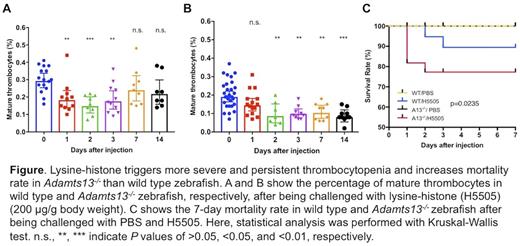Abstract
Background: Thrombotic thrombocytopenic purpura (TTP) is a potentially fatal syndrome, primarily resulting from a severe deficiency of plasma ADAMTS13 activity due to mutations in ADAMTS13 gene or autoantibodies against ADAMTS13. However, severe deficiency of plasma ADAMTS13 activity alone is often not sufficient to cause an acute episode; additional environmental and/or genetic factors may be required to trigger acute TTP.
Objectives: To address the potential triggers and identify novel therapeutic targets for TTP, we established and characterized a novel Adamts13-/- zebrafish line and determined the pathogenic role of lysine-histone in triggering TTP in both zebrafish and mice.
Methods and Results:CRISPR/Cas9 was employed to create an 8-nt deletion mutation in the signal peptide region of zebrafish Adamts13, resulting in complete deficiency of Adamts13 protein. Adamts13-/- zebrafish on the double transgenic (fli1-eGFP/gata1-dsRed) background showed normal size, morphology, and fertility except for the consistent appearance of a branching interseptal vessel. Adamts13-/- zebrafish larvae exhibited a significantly increased response to oxidative stress with an increased mortality rate and an accelerated rate of thrombus formation in microvasculature and caudal vessels after oxidative injury. Additionally, Adamts13-/- zebrafish demonstrated a significantly reduced number of circulating mature thrombocytes (thrombocytopenia) and an increased number of fragmented red blood cells (schistocytosis), consistent with the clinical phenotype of a spontaneous TTP. Moreover, plasma levels of histone/DNA complexes were found to be highly elevated in patients with acute TTP, but their pathogenic role is not known. Wild-Type and Adamts13-/- zebrafish and mice were challenged with a lysine rich-histone (H5505) intraperitoneally (200 μg/g body weight) and intravenously (20, 60, and 120 μg/g body weight), respectively. Complete blood counts were determined over a period of 14 and 3 days, respectively. We showed a more severe and persistent thrombocytopenia, increased fragmentation of red blood cells, as well as increased mortality rate in Adamts13-/- compared to Wild-Type zebrafish (Figure). Similar dose-dependent and profound thrombocytopenia was observed in Adamts13-/- but not in Wild-Type mice. Histological analysis of the organ tissues from Adamts13-/- zebrafish that died after histone challenge revealed the presence of microvascular thrombosis, supporting the diagnosis of TTP in these zebrafish.
Conclusions: These results demonstrate for the first time the success in establishing a zebrafish model of Adamts13-/- and TTP. Such a novel animal model enables us to rapidly evaluate the role of lysine-histone and many other potential environmental or genetic factors in the onset, progression, and outcome of TTP. This model may also help to identify novel therapeutic targets for both hereditary and acquired TTP in at an unprecedented pace.
Zheng: Alexion: Speakers Bureau; Ablynx: Consultancy.
Author notes
Asterisk with author names denotes non-ASH members.


This feature is available to Subscribers Only
Sign In or Create an Account Close Modal